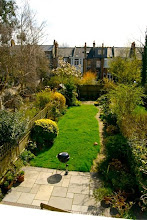

Thanks to Cornflower, I've got some new bedside reading, 'The Cookery Book of Lady Clark of Tillypronie'; and can therefore understand why Henry James and others were so enthusiastic about their hospitable hosts in Scotland. Lady Clark's recipes were published as a book in 1909, after her death, providing a comprehensive range that cater from the most conservative tastes (Balmoral Dessert Biscuits, often served at Tillypronie, from a recipe supplied by H.M. the Queen's Baker, at nearby Bamoral Castle), to the more arcane ('Ritualistic Haddock', 'Wet Devil', 'Boiled Angels', and 'Frog's Bones', which turn out to be crisp vanilla biscuits).
I don't think Frog's Bones will be served with the teas on Sunday afternoon at the Tillypronie garden opening, but there will be cake, so here is one of Lady Clark's three recipes for Gingerbread Cake.
1lb. treacle, 12 ozs. butter; put these into the oven to melt, and add to 1 lb. flour, 1/2 lb. moist sugar. Mix altogether with a little ginger and lemon peel; spread it then upon the tin to bake, and loosen it from the tin whilst still warm, or it will stick.
Cornflower may elucidate further on quantities, as I know she is very good at baking, but I think that for 'moist sugar', one might substitute soft dark brown sugar, and I like zesty gingery cakes, so I'd add more than a little ginger.
The other recipe that caught my eye -- well, actually, there were lots that did, but here is one of many -- is for Oeufs a la Bechamel, and it is labelled as Mesdames Langel's and Justine's Recipe, 1879. According to Lady Clark's husband, Sir John Clark, in a letter written from Tillypronie in 1901 to the future editor of his wife's book, she gathered a considerable knowledge of French and Italian cookery while he was serving in the Diplomatic Service in Paris, Brussels and Turin: 'she never failed, when any dish interested her, to cross-examine the artist the next day, who, perceiving the intelligent appreciation she evinced in his art, rarely failed to give her the best of his knowledge and experience.'
Presumably this explains the wealth of detail in the following recipe for Oeufs a la Bechamel:
Boil 6 eggs hard in boiling water, but not so hard as when cooked for canarybirds' food. To simmer only 10 minutes. When cold, peel off the shells, cut the eggs in two, lengthways, leave the yolks in and place the half-eggs, with the yolks uppermost, in an enamel dish capable of going into the oven, and put a tiny bit of fresh butter on the centre of the yolk of each half-egg. Pour the following sauce over all, and just colour in the oven, but not long enough to harden the whites.
For the Sauce: Rub 2 ozs. of fresh butter with flour and put into a saucepan. Stir well till it is smooth, taking care it does not burn. Add cream, or even milk, and stir on on till it is the proper thickness. Add salt, pepper, and a grate of nutmeg. Cook this thoroughly before pouring it over the eggs, then give them a minute in the oven, and brown with a salamander to a gold colour.
Yum yum.
And now back to Chanel, who I doubt ate much in the way of cake, even when she was in Scotland.


















